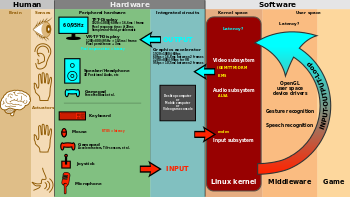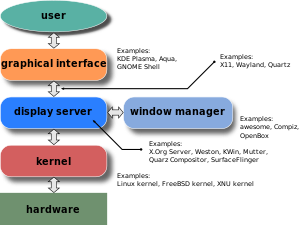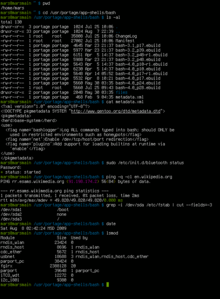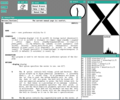Graphical user interface
This article needs additional citations for verification. (May 2022) |

A graphical user interface, or GUI (/ˈɡuːi/[1][2] GOO-ee), is a form of user interface that allows users to interact with electronic devices through graphical icons and visual indicators such as secondary notation. In many applications, GUIs are used instead of text-based UIs, which are based on typed command labels or text navigation. GUIs were introduced in reaction to the perceived steep learning curve of command-line interfaces (CLIs),[3][4][5] which require commands to be typed on a computer keyboard.
The actions in a GUI are usually performed through
GUI and interaction design

Designing the visual composition and temporal behavior of a GUI is an important part of
The visible graphical interface features of an application are sometimes referred to as chrome or GUI.
A GUI may be designed for the requirements of a
Cell phones and handheld game systems also employ application specific touchscreen GUIs. Newer automobiles use GUIs in their navigation systems and multimedia centers, or navigation multimedia center combinations.
Examples
- Sample graphical environments
-
MATE
-
Windows on an exampleWayland compositor
-
Sugar
-
A twm X Window System environment
Components

A GUI uses a combination of technologies and devices to provide a platform that users can interact with, for the tasks of gathering and producing information.
A series of elements conforming a visual language have evolved to represent information stored in computers. This makes it easier for people with few computer skills to work with and use computer software. The most common combination of such elements in GUIs is the windows, icons, text fields, canvases, menus, pointer (WIMP) paradigm, especially in personal computers.[15]
The WIMP style of interaction uses a virtual input device to represent the position of a pointing device's interface, most often a mouse, and presents information organized in windows and represented with icons. Available commands are compiled together in menus, and actions are performed making gestures with the pointing device. A window manager facilitates the interactions between windows, applications, and the windowing system. The windowing system handles hardware devices such as pointing devices, graphics hardware, and positioning of the pointer.
In personal computers, all these elements are modeled through a desktop metaphor to produce a simulation called a desktop environment in which the display represents a desktop, on which documents and folders of documents can be placed. Window managers and other software combine to simulate the desktop environment with varying degrees of realism.
Entries may appear in a list to make space for text and details, or in a grid for compactness and larger icons with little space underneath for text. Variations inbetween exist, such as a list with multiple columns of items and a grid of items with rows of text extending sideways from the icon.[16]
Multi-row and multi-column layouts commonly found on the web are "shelf" and "waterfall". The former is found on
display: inline-block;. A waterfall layout found on Imgur and TweetDeckcolumn-width:.
Post-WIMP interface
Smaller app mobile devices such as personal digital assistants (PDAs) and smartphones typically use the WIMP elements with different unifying metaphors, due to constraints in space and available input devices. Applications for which WIMP is not well suited may use newer interaction techniques, collectively termed post-WIMP UIs.[17]
As of 2011, some touchscreen-based operating systems such as Apple's iOS (iPhone) and Android use the class of GUIs named post-WIMP. These support styles of interaction using more than one finger in contact with a display, which allows actions such as pinching and rotating, which are unsupported by one pointer and mouse.[18]
Interaction
(translucent information devices at the eye level).There are also actions performed by programs that affect the GUI. For example, there are components like inotify or D-Bus to facilitate communication between computer programs.
History
Early efforts
The Xerox PARC GUI consisted of graphical elements such as
The first commercially available computer with a GUI was the 1979
Apple, Digital Research, IBM and Microsoft used many of Xerox's ideas to develop products, and IBM's Common User Access specifications formed the basis of the GUIs used in Microsoft Windows, IBM OS/2 Presentation Manager, and the Unix Motif toolkit and window manager. These ideas evolved to create the interface found in current versions of Microsoft Windows, and in various desktop environments for Unix-like operating systems, such as macOS and Linux. Thus most current GUIs have largely common idioms.

Popularization

GUIs were a hot topic in the early 1980s. The
In 1984, Apple released a television commercial which introduced the Apple Macintosh during the telecast of Super Bowl XVIII by CBS,[28] with allusions to George Orwell's noted novel Nineteen Eighty-Four. The goal of the commercial was to make people think about computers, identifying the user-friendly interface as a personal computer which departed from prior business-oriented systems,[29] and becoming a signature representation of Apple products.[30]
In 1985, Commodore released the Amiga 1000, along with Workbench and Kickstart 1.0 (which contained Intuition). This interface ran as a separate task, meaning it was very responsive and, unlike other GUIs of the time, it didn't freeze up when a program was busy. Additionally, it was the first GUI to introduce something resembling Virtual Desktops.
Windows 95, accompanied by an extensive marketing campaign,[31] was a major success in the marketplace at launch and shortly became the most popular desktop operating system.[32]
In 2007, with the iPhone[33] and later in 2010 with the introduction of the iPad,[34] Apple popularized the post-WIMP style of interaction for multi-touch screens, and those devices were considered to be milestones in the development of mobile devices.[35][36]
The GUIs familiar to most people as of the mid-late 2010s are Microsoft Windows, macOS, and the X Window System interfaces for desktop and laptop computers, and Android, Apple's iOS, Symbian, BlackBerry OS, Windows Phone/Windows 10 Mobile, Tizen, WebOS, and Firefox OS for handheld (smartphone) devices.[37][38]
Comparison to other interfaces
Command-line interfaces

Since the commands available in command line interfaces can be many, complex operations can be performed using a short sequence of words and symbols. Custom functions may be used to facilitate access to frequent actions. Command-line interfaces are more
GUIs can be made quite hard when dialogs are buried deep in a system or moved about to different places during redesigns. Also, icons and dialog boxes are usually harder for users to script.
WIMPs extensively use modes, as the meaning of all keys and clicks on specific positions on the screen are redefined all the time. Command-line interfaces use modes only in limited forms, such as for current directory and environment variables.
Most modern operating systems provide both a GUI and some level of a CLI, although the GUIs usually receive more attention.
GUI wrappers
GUI wrappers find a way around the command-line interface versions (CLI) of (typically) Linux and Unix-like software applications and their text-based UIs or typed command labels. While command-line or text-based applications allow users to run a program non-interactively, GUI wrappers atop them avoid the steep learning curve of the command-line, which requires commands to be typed on the keyboard. By starting a GUI wrapper, users can intuitively interact with, start, stop, and change its working parameters, through graphical icons and visual indicators of a desktop environment, for example. Applications may also provide both interfaces, and when they do the GUI is usually a WIMP wrapper around the command-line version. This is especially common with applications designed for Unix-like operating systems. The latter used to be implemented first because it allowed the developers to focus exclusively on their product's functionality without bothering about interface details such as designing icons and placing buttons. Designing programs this way also allows users to run the program in a shell script.
Three-dimensional graphical user interface
Many environments and games use the methods of
The GUI is usually WIMP-based, although occasionally other metaphors surface, such as those used in
In science fiction
3D GUIs have appeared in science fiction literature and films, even before certain technologies were feasible or in common use.[45]
- In prose fiction, 3D GUIs have been portrayed as immersible environments, ".
- The 1993 American film Jurassic Park features Silicon Graphics' 3D file manager File System Navigator, a real-life file manager for Unix operating systems.
- The film Minority Report has scenes of police officers using specialized 3D data systems.
See also
- Apple Computer, Inc. v. Microsoft Corp.
- Console user interface
- Computer icon
- Distinguishable interfaces
- General Graphics Interface (software project)
- GUI tree
- Human factors and ergonomics
- Look and feel
- Natural user interface
- Ncurses
- Object-oriented user interface
- Organic user interface
- Rich web application
- Skeuomorph
- Theme (computing)
- Text entry interface
- Transportable Applications Environment
- User experience design
- User interface design
- Vector-based graphical user interface
References
- ISBN 978-1-4058-8118-0.
- ^ "How to pronounce GUI in English". Cambridge Dictionary. Retrieved 2020-04-03.
- ^ a b "Command line vs. GUI". Computer Hope. Retrieved 2020-04-03.
- ^ "The GUI versus the Command Line: Which is better? (Part 1)". Microsoft.com Operations. Microsoft Learn. 2007-03-12. Retrieved 2024-01-30.
- ^ "The GUI versus the Command Line: Which is better? (Part 2)". Microsoft.com Operations. Microsoft Learn. 2007-03-26. Retrieved 2024-01-30.
- ^ "Graphical user interface". ScienceDaily. Retrieved 2019-05-09.
- ^ Levy, Steven. "Graphical User Interface (GUI)". Britannica.com. Retrieved 2019-06-12.
- ^ "GUI". PC Magazine Encyclopedia. pcmag.com. Retrieved 2019-06-12.
- Gamasutra. Archived from the originalon January 19, 2010. Retrieved February 14, 2006.
- ^ "GUI definition". Linux Information Project. October 1, 2004. Retrieved 12 November 2008.
- ^ "chrome". www.catb.org. Retrieved 2020-04-03.
- ^ Nielsen, Jakob (January 29, 2012). "Browser and GUI Chrome". Nngroup. Archived from the original on August 25, 2012. Retrieved May 20, 2012.
- S2CID 60467930.
- ^ Bisson, Giselle. "The ViewTouch restaurant system".
- ^ "What is a graphical user interface (GUI)?". IONOS Digitalguide. 14 September 2020. Retrieved 2022-02-25.
- ^ Babich, Nick (30 May 2020). "Mobile UX Design: List View and Grid View". Medium. Retrieved 4 September 2021.
- .
- ^ "Reality-Based Interaction: A Framework for Post-WIMP Interfaces".
- ^ Lieberman, Henry. "A Creative Programming Environment, Remixed", MIT Media Lab, Cambridge.
- ^ Salha, Nader. "Aesthetics and Art in the Early Development of Human-Computer Interfaces" Archived 2020-08-07 at the Wayback Machine, October 2012.
- ^ Smith, David (1975). "Pygmalion: A Creative Programming Environment".
- ^ The first GUIs
- ^ Xerox Star user interface demonstration, 1982
- ^ "VisiCorp Visi On".
The Visi On product was not intended for the home user. It was designed and priced for high-end corporate workstations. The hardware it required was quite a bit for 1983. It required a minimum of 512k of ram and a hard drive (5 megs of space).
- ^ A Windows Retrospective, PC Magazine Jan 2009. Ziff Davis. January 2009.
- ^ "Magic Desk I for Commodore 64".
- ^ Sandberg-Diment, Erik (1984-12-25). "Value of Windowing is Questioned". The New York Times.
- ^ Friedman, Ted (October 1997). "Apple's 1984: The Introduction of the Macintosh in the Cultural History of Personal Computers". Archived from the original on October 5, 1999.
- ISBN 978-0-8147-2740-9. Retrieved October 6, 2011.
- ^ Grote, Patrick (October 29, 2006). "Review of Pirates of Silicon Valley Movie". DotJournal.com. Archived from the original on November 7, 2006. Retrieved January 24, 2014.
- ^ Washington Post (August 24, 1995). "With Windows 95's Debut, Microsoft Scales Heights of Hype". Washington Post. Retrieved November 8, 2013.
- ^ "Computers | Timeline of Computer History | Computer History Museum". www.computerhistory.org. Retrieved 2017-04-02.
- Ryerson Review of Journalism, (February 19, 2007) Retrieved February 19, 2007
- ^ "the iPad could finally spark demand for the hitherto unsuccessful tablet PC" --Eaton, Nick The iPad/tablet PC market defined? Archived 2011-02-01 at the Wayback Machine, Seattle Post-Intelligencer, 2010
- ^ Bright, Peter Ballmer (and Microsoft) still doesn't get the iPad, Ars Technica, 2010
- ^ "The iPad's victory in defining the tablet: What it means". InfoWorld. 2011-07-05.
- ISSN 0024-2586.
- ^ "What is a Graphical User Interface? Definition and FAQs | OmniSci". omnisci.com. Retrieved 2022-01-26.
- ^ "3D Mailbox – 3-Dimensional Email Software. Bring e-mail to life! Email just got cool and fun". 3dmailbox.com. Archived from the original on 2019-07-21. Retrieved 2022-07-14.
- ^ "3D Mailbox". Download.com. Retrieved 2022-07-14.
- ^ Macworld.com November 11, 2006. Dan Moren. CES Unveiled@NY ‘07: Point and click coming to set-top boxes? Archived 2011-11-08 at the Wayback Machine
- ^ "Metisse – New Looking Glass Alternative". 29 June 2004. Retrieved 2 July 2020.
- ^ Smith, David A.; Kay, Alan; Raab, Andreas; Reed, David P. "Croquet – A Collaboration System Architecture" (PDF). croquetconsortium.org. Archived from the original (PDF) on 2007-09-27. Retrieved 2022-09-17.
The efforts at Xerox PARC under the leadership of Alan Kay that drove the development of [...] powerful bit-mapped display based user interfaces was key. In some ways, all we are doing here is extending this model to 3D and adding a new robust object collaboration model.
- ^ Purwar, Sourabh (2019-03-04). "Designing User Experience for Virtual Reality (VR) applications". Medium. Retrieved 2022-05-06.
- ^ Dayton, Tom. "Object-Oriented GUIs are the Future". OpenMCT Blog. Archived from the original on 10 August 2014. Retrieved 23 August 2012.
External links
- Evolution of Graphical User Interface in last 50 years by Raj Lal
- The men who really invented the GUI by Clive Akass
- Graphical User Interface Gallery, screenshots of various GUIs
- Marcin Wichary's GUIdebook, Graphical User Interface gallery: over 5500 screenshots of GUI, application and icon history
- The Real History of the GUI by Mike Tuck
- In The Beginning Was The Command Line by Neal Stephenson
- 3D Graphical User Interfaces (PDF) by Farid BenHajji and Erik Dybner, Department of Computer and Systems Sciences, Stockholm University
- Topological Analysis of the Gibbs Energy Function (Liquid-Liquid Equilibrium Correlation Data). Including a Thermodinamic Review and a Graphical User Interface (GUI) for Surfaces/Tie-lines/Hessian matrix analysis – University of Alicante (Reyes-Labarta et al. 2015–18)
- Innovative Ways to Use Information Visualization across a Variety of Fields by Ryan Erwin Digital marketing specialist (CLLAX) (2022-05)











